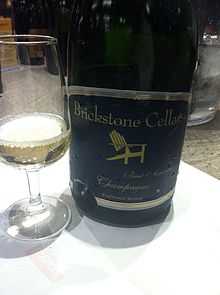Finger Lakes AVA
| Wine region | |
 Sparkling wine made in the Finger Lakes region of New York | |
| Type | American Viticultural Area |
|---|---|
| Year established | 1982, amended in 1987[1] |
| Country | United States |
| Part of | New York |
| Sub-regions | Cayuga Lake AVA, Seneca Lake AVA |
| Climate region | Continental |
| Total area | 2,600,000 acres (1,052,183 ha)[2] |
| Size of planted vineyards | 11,000 acres (4,452 ha)[3] |
| Grapes produced | Baco noir, Cabernet Franc, Cabernet Sauvignon, Catawba, Cayuga White, Chambourcin, Chancellor, Chardonnay, Chelois, Colobel, Concord, Corot noir, De Chaunac, Delaware, Diamond, Dornfelder, Gamay noir, Geisenheim, Gewürztraminer, Himrod, Isabella, Ives noir, Lakemont, Lemberger, Leon Millot, Malbec, Marechal Foch, Melody, Merlot, Muscat Canelli, Muscat Ottonel, Niagara, Noiret, Pinot blanc, Pinot gris, Pinot Meunier, Pinot noir, Riesling, Rkatsiteli, Rougeon, Saperavi, Sauvignon blanc, Sereksiya Charni, Severnyi, Seyval blanc, Siegfried, St. Vincent, Syrah, Traminette, Verdelet, Vidal blanc, Vignoles, Villard noir, Villard blanc, Vincent, Viognier[3] |
| No. of wineries | 103[3] |
The Finger Lakes AVA is an American Viticultural Area located in Upstate New York, south of Lake Ontario. The Finger Lakes encompass eleven glacial lakes, but the area around Canandaigua, Keuka, Seneca, and Cayuga Lakes contain the vast majority of vineyard plantings in the AVA. Cayuga and Seneca Lakes each have their own American Viticultural Areas completely contained within the Finger Lakes AVA (Cayuga Lake AVA and Seneca Lake AVA). The Finger Lakes AVA includes 11,000 acres (4,452 ha) of vineyards and is the largest wine-producing region in New York State.[4]
Climate
The Finger Lakes AVA wine region is often compared to the German wine regions along the Rhine river. Riesling, one of the most important commercial wine grape varieties grown in Germany, is also one of the most successful grape varieties grown in the Finger Lakes AVA. Viticulturists in the Finger Lakes region grow a wide variety of grapes besides Riesling, including other European Vitis vinifera grapes, native American grapes, as well as French-American hybrid varieties.[5][6][7]
The deep lakes in the region help to moderate the local microclimate. Stored heat is released from the deep lakes during the winter, keeping the local climate mild relative to surrounding areas and preventing early season frost. Most vineyards are planted on steep hillsides overlooking the lakes, which help provide the vines with good drainage, better sun exposure, and a reduced risk of frost.
The region averages over 30 inches (76 cm)[8][9] of precipitation a year. The soil in the region is generally deep, providing good drainage, however there are some areas, such as on the west side of Seneca Lake, where the bedrock is close to the surface.
History
The first record of wine making in the Finger Lakes is in 1829, when William Warner Bostwick, an Episcopal minister in Hammondsport, planted Vitis labrusca shoots in his rectory garden. Commercial viticulture officially began in 1862, when the Hammondsport and Pleasant Valley Wine Companies were founded. Two more companies were formed three years later. The region became famous for its sparkling wines, with the Pleasant Valley Wine Company winning European awards in 1867 and 1873. These successes spurred growth in commercial plantings in the area, and by the end of the century there was 25,000 acres (10,117 ha) planted.
A number of factors, including phylloxera, competition from California, and prohibition, combined to cause a decline in commercial viticulture production in the early 20th century. Production resumed on a smaller scale after Prohibition was repealed. After World War II, soldiers returning from Europe had developed a taste for drier wines from Vitis vinifera varieties, as opposed to the sweeter wines produced from native American grape varieties. Unlike in California, winemakers in the Finger Lakes were unable to grow Vitis vinifera in the harsh winters. They experimented with French-American hybrid varieties with limited success.[10]
A major change in Finger Lakes viticulture occurred when Dr. Konstantin Frank, a Ukrainian immigrant with a PhD in Plant Science, came to work for the Cornell University Geneva Experiment station in 1951. Commercial growers and researchers at the Geneva Experiment Station were convinced that European Vitis vinifera varietals could not grow in the cold Finger Lakes climate. After years of planting Vitis vinifera in the colder climate of the Ukraine, Dr. Frank was sure that it could be grown in the Finger Lakes if grafted onto the proper, cold-hardy native rootstock. He proved this in 1962 when he started Vinifera Wine Cellars, in Hammondsport. Dr. Frank successfully grew and produced wine from Vitis vinifera grapes such as Riesling, Chardonnay, Pinot noir, Gewürztraminer, and Cabernet Sauvignon, grafted onto native rootstock. Plantings of Vitis vinifera varieties spread throughout the region, reinvigorating the Finger Lakes wine region's growth and popularity.
As of 2008, there are nearly one hundred wineries in operation in the Finger Lakes AVA.[5]
References
- ↑ Code of Federal Regulations. "§ 9.34 Finger Lakes." Title 27: Alcohol, Tobacco and Firearms; Part 9 — American Viticultural Areas; Subpart C — Approved American Viticultural Areas. Retrieved Feb. 6, 2008.
- ↑ Wine Lover's Companion (2003). "Finger Lakes AVA". Barron's Educational Series, Inc. Retrieved Feb. 6, 2008.
- ↑ 3.0 3.1 3.2 Appellation America (2007). "Finger Lakes (AVA): Appellation Description". Retrieved Feb. 6, 2008.
- ↑ "Finger Lakes Wine Region Description". Retrieved 2014-04-04.
- ↑ 5.0 5.1 "Finger Lakes Wine Alliance". Retrieved 2009-01-01.
- ↑ "Fine Rieslings Flourish in New York Finger Lakes: John Mariani". Bloomberg. Retrieved 2009-01-01.
- ↑ Berger, Dan (July 18, 2007). "The Coming Riesling Resurgence Finger Lakes Wines Are Hands Up Leaders". Appelation America. Retrieved 2009-01-01.
- ↑ "Monthly Averages for Rochester, New York". NOAA. Retrieved 2009-01-01.
- ↑ "Monthly Averages for Canandaigua, New York". The Weather Channel. Retrieved 2009-01-01.
- ↑ Vines, Wines, and Regional Identity in the Finger Lakes Region,James L. Newman Geographical Review, Vol. 76, No. 3 (Jul., 1986), pp. 301–316